Gray Bill Blue Hat Birds on Bat Cardinal Hat
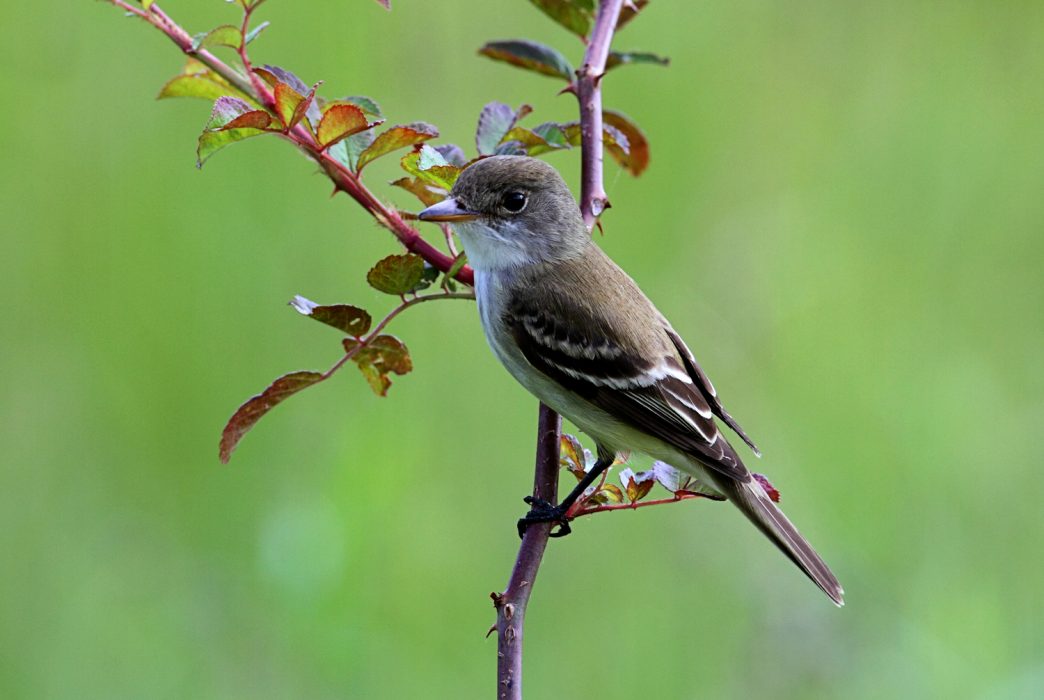
There are many gray birds and so identifying them could be hard until now.
Check out these birds and see if you find the gray bird you're looking for in this list of common gray birds found in the US and Canada.
Find out whether the bird is a phoebe or a warbler, gnatcatcher, or flycatcher.
These are 21 common gray birds you will see either in your backyard or when you are out in the woods and meadows.
Also, get this free picture ID printable for backyard birds for every state to really get you birding.
21 Common Gray Birds
- Dark-eyed Junco
- Gray Catbird
- Black-capped Chickadee
- Northern Mockingbird
- White-breasted Nuthatch
- Tufted Titmouse
- Carolina Chickadee
- Black Phoebe
- Northern Parula
- Blue-Gray Gnatcatcher
- Willow Flycatcher
- Loggerhead Shrike
- Rock Pigeon
- Warbling Vireo
- Bushtit
- Eurasian Collard Dove
- Eastern Kingbird
- White-winged Dove
- Black-and-white Warbler
- Eastern Wood-pewee
- Say's Phoebe
21 Common Gray Birds
1. Dark-eyed Junco
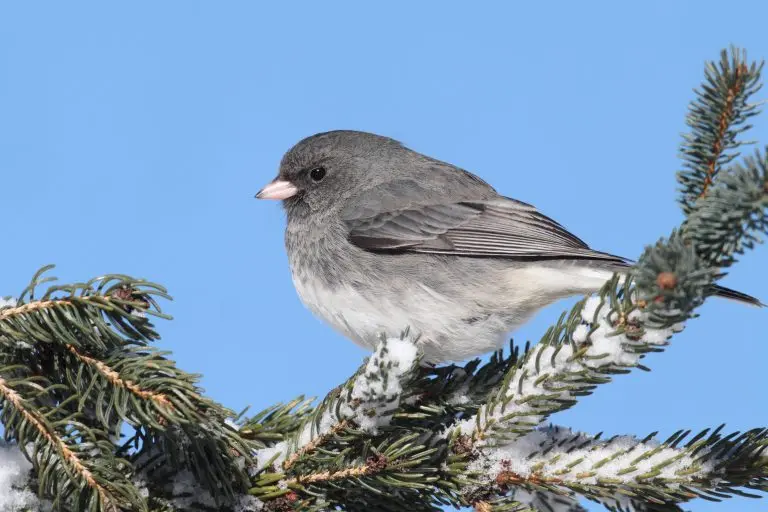
Dark-eyed Juncos are sparrows that are different colors depending on the state. They are generally slate-colored in the east and black, white, and brown in the west.
- Length: 5.5-6.3 in (14-16 cm)
- Weight: 0.6-1.1 oz (18-30 g)
- Wingspan: 7.1-9.8 in (18-25 cm)
Some remain resident all year in the northeast, west and in the Appalachian Mountains. Those that breed in Canada and Alaska migrate south in winter to much of the United States.
They can be found in open and partially wooded areas often on the ground and are common across the continent.
You can attract more Dark-eyed Juncos to backyard feeders with a variety of seeds such as black oil sunflower seeds, nyjer, cracked corn, millet, and peanuts. Platform feeders or scattered on the ground are best.
2. Gray Catbird
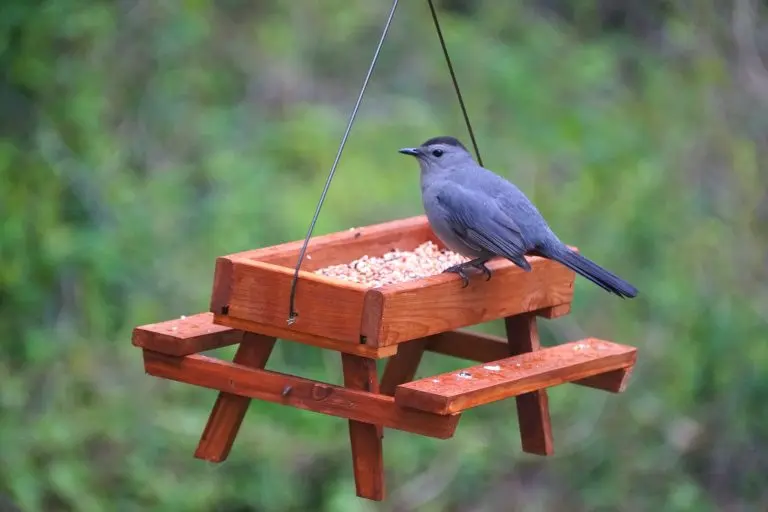
Gray Catbirds are so named because of their distinctive catty mew song that can last for up to 10 minutes. They are medium-sized songbirds with a slate gray coloring, black cap and tail, and a reddish patch under their tails.
- Length: 8.3-9.4 in (21-24 cm)
- Weight: 0.8-2.0 oz (23.2-56.5 g)
- Wingspan: 8.7-11.8 in (22-30 cm)
Gray Catbirds breed in the Mid-west, Eastern States and southern Canad before heading to the Gulf Coast and the Caribbean for winter. Some remain all year along the East Coast.
You can spot Gray Catbirds in dense shrubs, small trees, and along forest edges or hedgerows.
You can attract more Gray Catbirds to your backyard feeders with fruit and fruit trees or shrubs such as dogwood, winterberry, and serviceberry.
3. Black-capped Chickadee
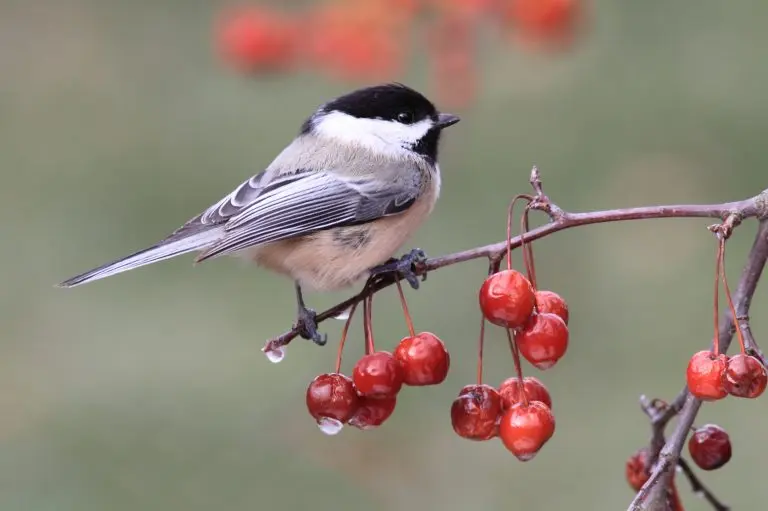
The Black-capped Chickadee is a cute bird with a big round head and tiny body. These birds will happily feed at backyard feeders and will investigate everything including you!
They have black caps and beaks, white cheeks, and are gray on the back, wings, and tail.
- Length: 4.7-5.9 in (12-15 cm)
- Weight: 0.3-0.5 oz (9-14 g)
- Wingspan: 6.3-8.3 in (16-21 cm)
Black-capped Chickadees live in the Northwest, Midwest and Northern States and Canada all year.
They can be found in forests, open woods, parks. Black-capped Chickadees eat seeds, berries and insects, spiders, and suet.
To attract more Black-capped Chickadees to your backyard try suet, sunflower seeds, and peanuts or peanut butter. They will even feed from your hand and are often one of the first birds to discover new feeders. They will also use nest boxes, especially if you fill them with wood shavings.
4. Northern Mockingbird
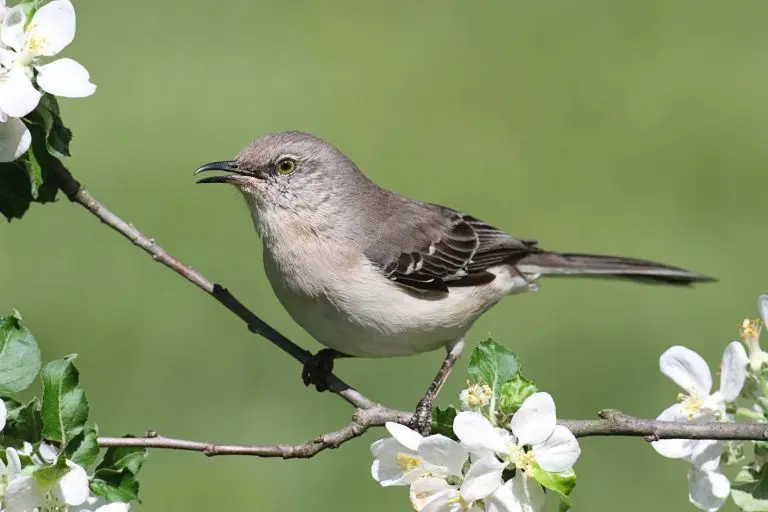
Northern Mockingbirds are medium-sized songbirds with small heads and long tails. They are a gray-brown color and slightly paler on the underside compared to the back. They have two white wingbars visible in flight.
They are usually seen alone or in pairs and aggressively defend their territory. A male mockingbird can learn around 200 songs in its life, copying other birds' songs and they can sing all through the day and into the night.
Residents in southern and eastern states but may migrate from the north of their range.
They don't often visit feeders but will come to open lawn areas. To attract more Northern Mockingbirds try planting fruiting trees or bushes, including hawthorns, mulberries, and blackberry brambles.
5. White-breasted Nuthatch
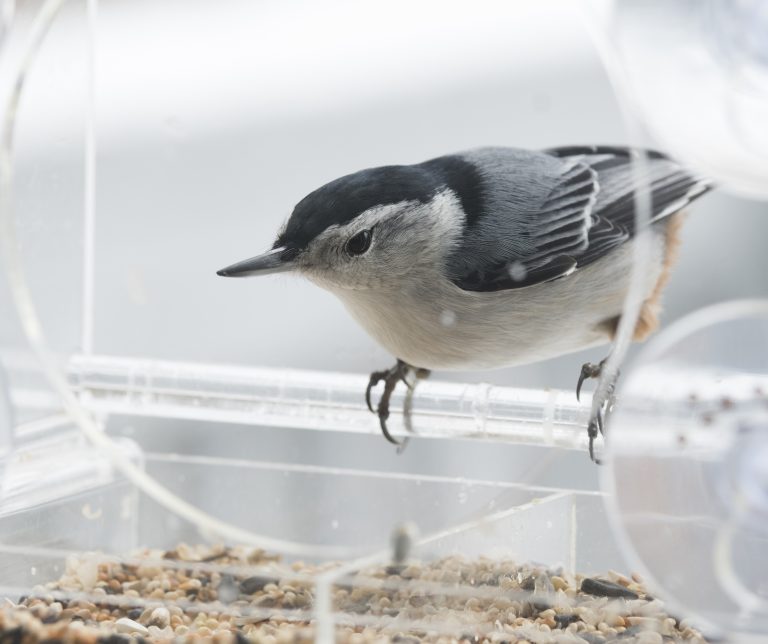
White-breasted Nuthatches are active little birds that are gray-blue on the back and white on the face and belly, with a black cap.
They will often have a chestnut color on the lower belly and under the tail.
- Length: 5.1-5.5 in (13-14 cm)
- Weight: 0.6-1.1 oz (18-30 g)
- Wingspan: 7.9-10.6 in (20-27 cm)
White-breasted Nuthatches live all year in most US States and Southern Canada.
They can be found in deciduous forests, woodland edges, parks, and yards with trees or at feeders. They mainly eat insects including beetles and their larvae, caterpillars, ants, and also spiders.
White-breasted Nuthatches also eat seeds and nuts including acorns, hawthorns, sunflower seeds, and sometimes corn crops.
They jam large nuts and acorns into tree bark and then whack them with their bills to open or 'hatch' them to get the seed out.
You can attract more White-breasted Nuthatches to your backyard with sunflower seeds and peanuts on tube feeders or suet feeders.
6. Tufted Titmouse
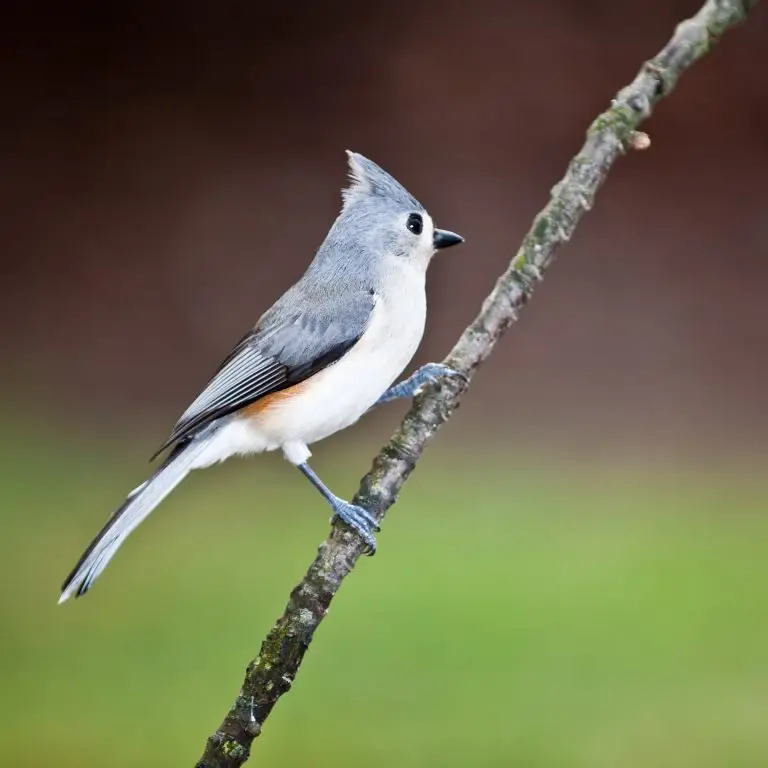
The Tufted Titmouse is gray on the back and white underneath with a cute gray crest and large eyes that often flock with chickadees, nuthatches, and woodpeckers.
- Length: 5.5-6.3 in (14-16 cm)
- Weight: 0.6-0.9 oz (18-26 g)
- Wingspan: 7.9-10.2 in (20-26 cm)
Tufted Titmice live in Eastern and Southeastern States all year
Tufted Titmice can be assertive over smaller birds and are found in woodlands, parks, and at backyard feeders. They eat mostly insects in summer including caterpillars, beetles, ants, and wasps as well as spiders and snails. They will also eat seeds, nuts, and berries and will hoard shelled seeds.
You can attract Tufted Titmice to your backyard feeders with sunflower seeds, suet, and peanuts on tube feeders or suet cages. They will also eat from platform feeders. You can also try putting up a nest box to attract a breeding pair.
Check out these articles if you want to know more about birds in North America:
- Backyard Birds in Every State – Free Picture ID Printable
- Hummingbirds in North America
- Birds with Red Heads
- Male or Females Hummingbird Picture ID guide
7. Carolina Chickadee
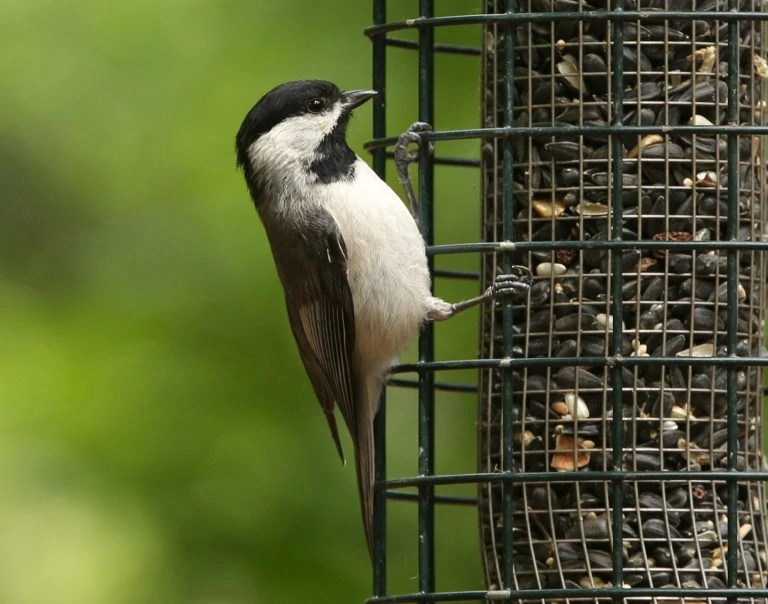
Carolina Chickadees are tiny birds with large heads, black cap and neck, white cheeks and belly, and soft gray back, wings, and tail.
- Length: 3.9-4.7 in (10-12 cm)
- Weight: 0.3-0.4 oz (8-12 g)
- Wingspan: 5.9-7.9 in (15-20 cm)
They are visually very similar to the Black-capped Chickadee and they interbreed where their range overlaps.
They can be found in forested areas, parks, and backyards in Eastern and Southeastern States all year.
You can attract more Carolina Chickadees to your backyard feeders with Black oil sunflower seeds, Nyjer seeds, suet feeders, or peanuts. They will feed on most types of feeders including tube feeders, suet cages, or platform feeders. They will also nest in nest boxes or nest tubes.
8. Black Phoebe
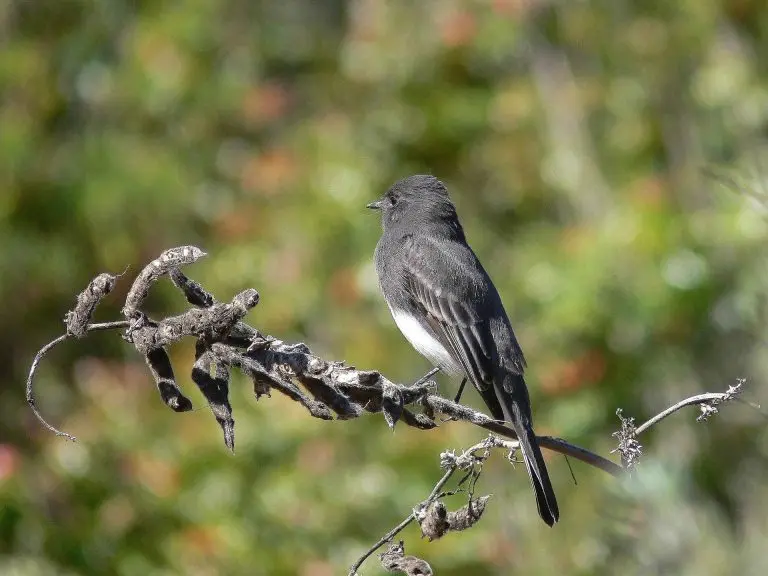
Black Phoebes are small, plump flycatchers that are black on the back, head, and chest and white underneath. They can look gray in some light.
- Length: 6.3 in (16 cm)
- Weight: 0.5-0.8 oz (15-22 g)
They are mostly resident across Southwestern States, Mexico and Central America. Some in the north of this range may migrate south after breeding.
Black Phoebes can usually be found near water such as coastal areas, rivers, lakes, or ponds. They perch above the ground and wait for insects or arthropods to come along, such as beetles, grasshoppers, wasps, flies, bees, and spiders.
To attract Black Phoebes to your yard try adding water features and native plants to attract insects. They may also build a nest under the eaves if there is a source of mud nearby to build their nest out of.
9. Northern Parula
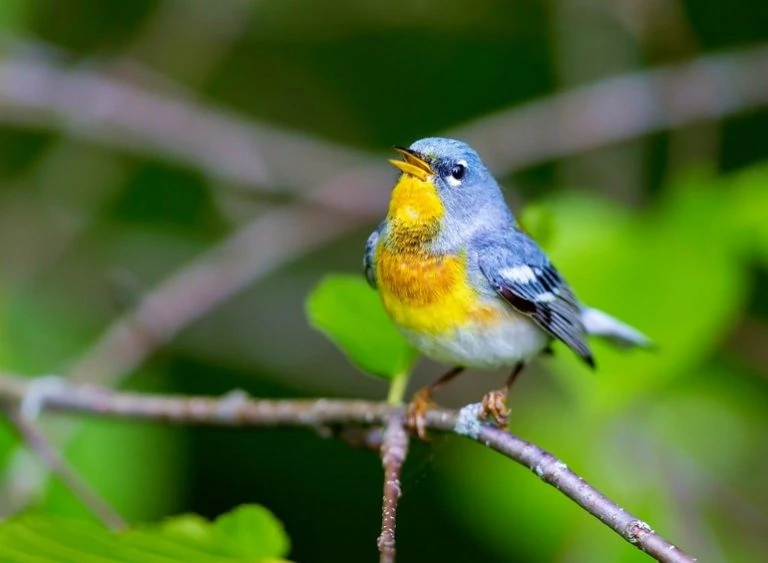
With a colorful contrast of gray and yellow the Northern Parula is a cheery warbler found in woodlands.
They are bluish-gray on the back with a yellow patch on the back and with two white wingbars. Males have a chestnut band that separates the yellow throat and chest that adorns both males and females. Females are paler than males.
- Length: 4.3-4.7 in (11-12 cm)
- Weight: 0.2-0.4 oz (5-11 g)
- Wingspan: 6.3-7.1 in (16-18 cm)
Northern Parulas breed in the Eastern States and southeastern Canada before heading to Central America and the Caribbean for winter. They may remain for winter in southern Florida.
Feeding on insects high up in deciduous forests and building nests in long clumps of lichen and moss that drape from the branches. The best way to spot them is by looking up at large clumps of hanging moss in the summer.
10. Blue-gray Gnatcatcher

Blue-gray Gnatcatchers are tiny songbirds with a soft blue-gray color on the back and grayish-white underneath. They have a black tail and patches on their wings. Males have a distinctive black 'V' shape on their foreheads in summer.
They have long tails and legs and small, thin, straight bills.
- Length: 3.9-4.3 in (10-11 cm)
- Weight: 0.2-0.3 oz (4.8-8.9 g)
- Wingspan: 6.3 in (16 cm)
Blue-gray Gnatcatchers breed in deciduous forests in the Southern and Eastern States before heading south. They also remain all year in Florida and in southern coastal areas.
Nests of Blue-gray Gnatcatchers look similar to hummingbird nests as they are small and built onto branches so they look like a tree knot covered in lichen.
Feeding on insects and spiders by constantly hopping around and scaring them by flicking their tail up and down.
11. Willow Flycatcher
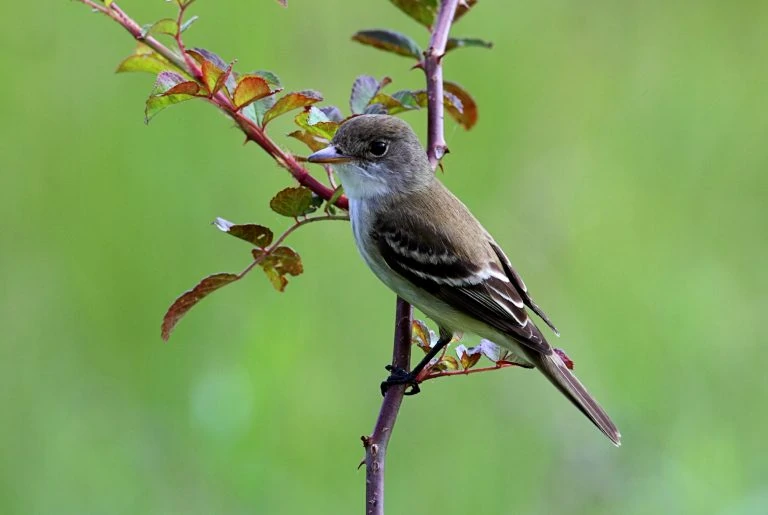
Willow Flycatchers are grayish-brown and with olive tones. Their bellies are gray with yellow tones.
- Length: 5.1-6.7 in (13-17 cm)
- Weight: 0.4-0.6 oz (11-16 g)
- Wingspan: 7.5-9.4 in (19-24 cm)
Willow Flycatchers breed in northwestern states and meadows of the mountainous west before heading to Mexico and Central America. They can also be seen during migration in all US states.
12. Loggerhead Shrike
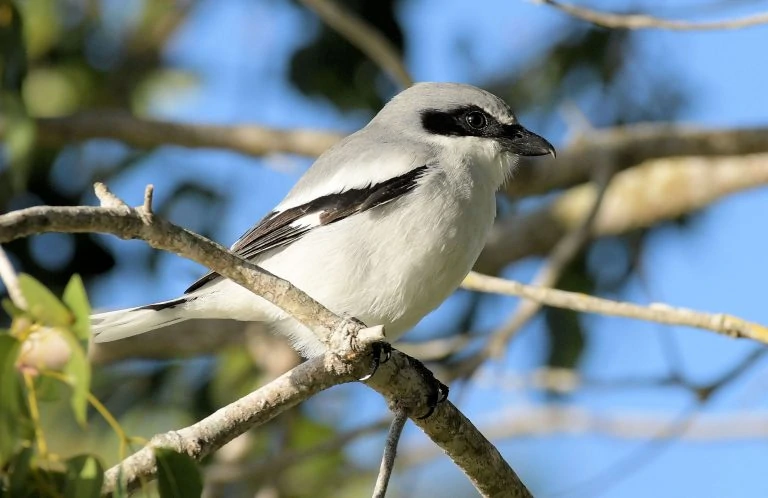
A songbird with the heart of a raptor, Loggerhead Shrikes are gray birds with a black mask and wings.
- Length: 7.9-9.1 in (20-23 cm)
- Weight: 1.2-1.8 oz (35-50 g)
- Wingspan: 11.0-12.6 in (28-32 cm)
Loggerhead Shrikes live all year in the lower half of the US but will also travel north to breed in the summer before returning south.
The predatory gray birds hunt other birds, insects, lizards and small mammals. They will skewer their prey on thorns or squeeze them into tight spaces to devour them.
They can be found in open habitats often perched watching for prey.
13. Rock Pigeon
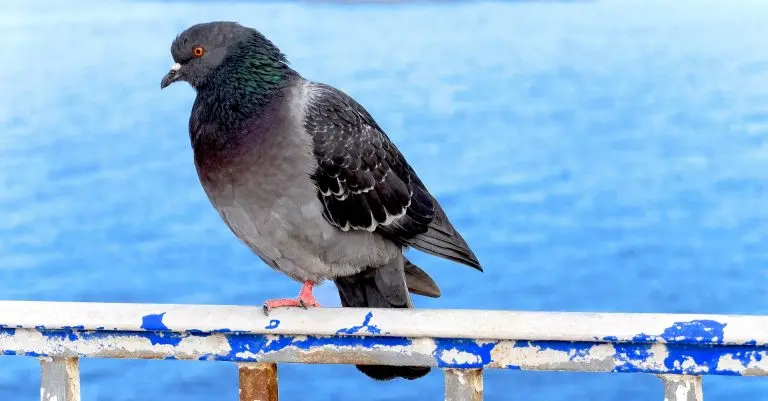
Rock Pigeons are blueish gray with two black bands on the wing and black on the tail tip. They have iridescent throat feathers and orange eyes.
- Length: 11.8-14.2 in (30-36 cm)
- Weight: 9.3-13.4 oz (265-380 g)
- Wingspan: 19.7-26.4 in (50-67 cm)
They are common in cities but also visit backyards to find food on the ground. Some cities have ordinances against feeding pigeons as they are considered pests.
14. Warbling Vireo
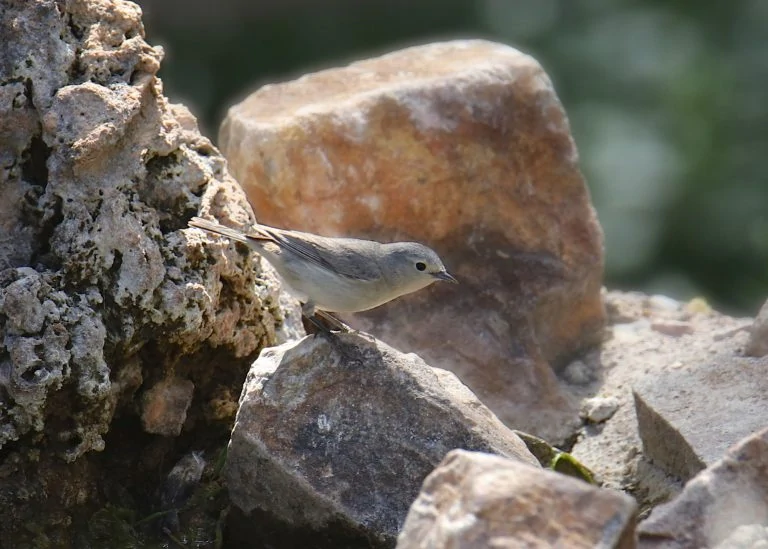
Warbling Vireos are gray and olive birds and lighter whiteish-yellow underneath.
- Length: 4.7-5.1 in (12-13 cm)
- Weight: 0.3-0.6 oz (10-16 g)
- Wingspan: 8.7 in (22 cm)
Warbling Vireos breed over most of the US and into northwestern Canada, except the Gulf Coast. They spend winter in Mexico and Central America.
They can be difficult to find as they stay high up in the trees.
15. Bushtit
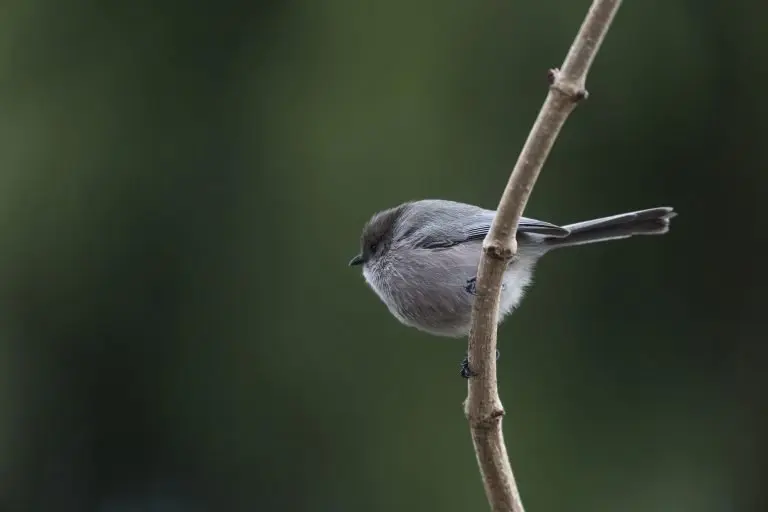
Bushtits are tiny, almost round, soft gray birds with a long tail and stubby bill. They have slight brown tinges to the face and underneath.
- Length: 2.8-3.1 in (7-8 cm)
- Weight: 0.1-0.2 oz (4-6 g)
Bushtits live all year in the Western States.
They can be found in open woodland or scrubby areas, parks, and backyards. Their diet is insects and spiders, such as caterpillars, beetle, wasps, and ants.
Bushtits make amazing hanging nests out of plant material and spider webs that hang down about a foot and may take a month to build.
To attract more bushtits to your yard plant native shrubs and trees and they may visit feeders filled with black oil sunflower seeds, suet, or mealworms from platform feeders.
16. Eurasian Collard Dove
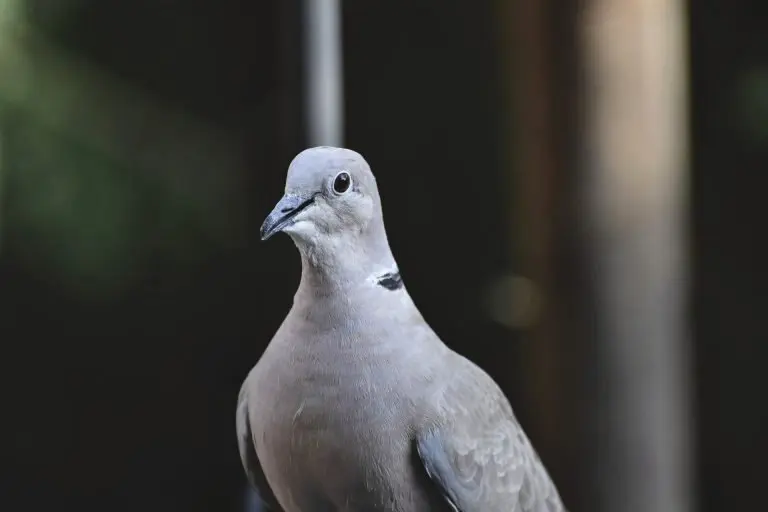
Eurasian-collard Doves are light brownish-gray, with white patches in the tail, and look very similar to Mourning Doves, but with a black half collar at the nape of the neck, they are also larger, and with a square tail rather than pointed.
- Length: 11.4-11.8 in (29-30 cm)
- Weight: 4.9-6.3 oz (140-180 g)
- Wingspan: 13.8 in (35 cm)
Eurasian Collared-Doves are an introduced species that only arrived in the 1980s but nowlive across most of the country.
Eurasian Collared-Doves eat a wide variety of seeds and grain but also will eat some berries and insects.
17. Eastern Kingbird
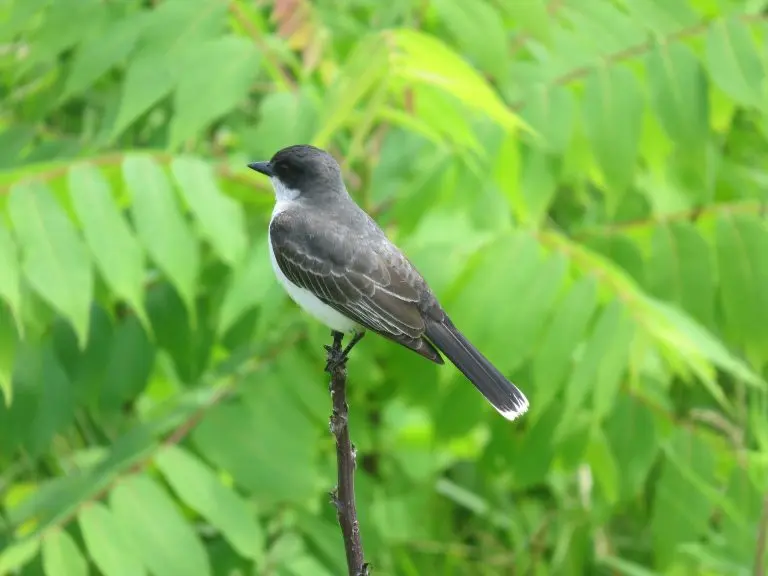
Eastern Kingbirds are medium-sized, large-headed flycatchers that are grayish-black on the back and white underneath. Their heads are darker black and they have a white tip on the tail.
- Length: 7.5-9.1 in (19-23 cm)
- Weight: 1.2-1.9 oz (33-55 g)
- Wingspan: 13.0-15.0 in (33-38 cm)
They get their name 'king' from the aggression they show each other and other birds when defending their nests.
They have a concealed crown, of yellow, orange, or red feathers, which they raise when defending themselves or their nest.
Eastern Kingbirds breed in most of the U.S except the Southwestern States, before heading south into Central and South America for winter. They usually breed in fields, orchards, and along forest edges. They can often be found nesting near water such as rivers or lakes.
Eastern Kingbirds catch insects in midair. They will often perch up above fields waiting for insects to fly past.
18. White-winged Dove
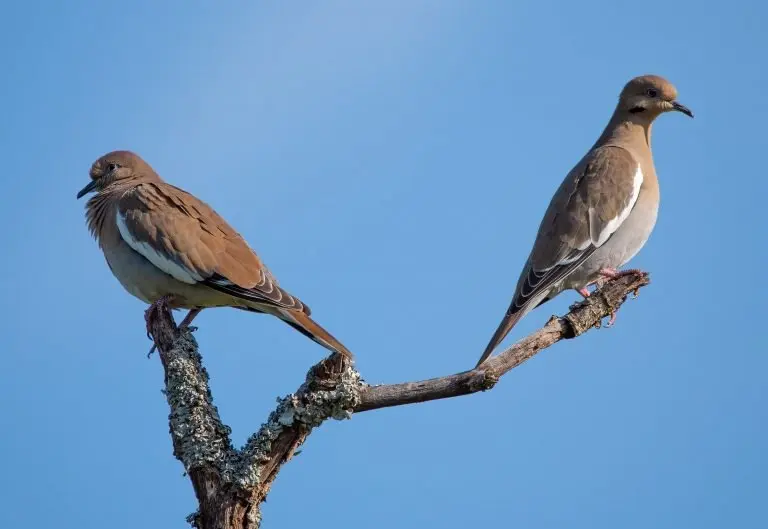
White-winged Doves are pale gray-brown with a black line on the cheek and a white stripe on the edge of the closed wing, which is striking on the middle of a dark wing in flight.
- Weight: 4.4-6.6 oz (125-187 g)
- Wingspan: 18.9-22.8 in (48-58 cm)
Found along the southern border with Mexico and into Mexico, Central America, and the West Indies. Those to the north of the range may move south towards the Gulf Coast or into Mexico for winter.
White-winged Doves live in deserts, dense, thorny forests, woodlands, and suburban areas. Their diet is mostly grain and also fruits and large seeds and are found foraging on the ground.
To attract more White-winged Doves to your yard try sunflower, corn, safflower, and milo on platform feeders. Also, plant native berry-producing shrubs.
19. Black-and-white Warbler
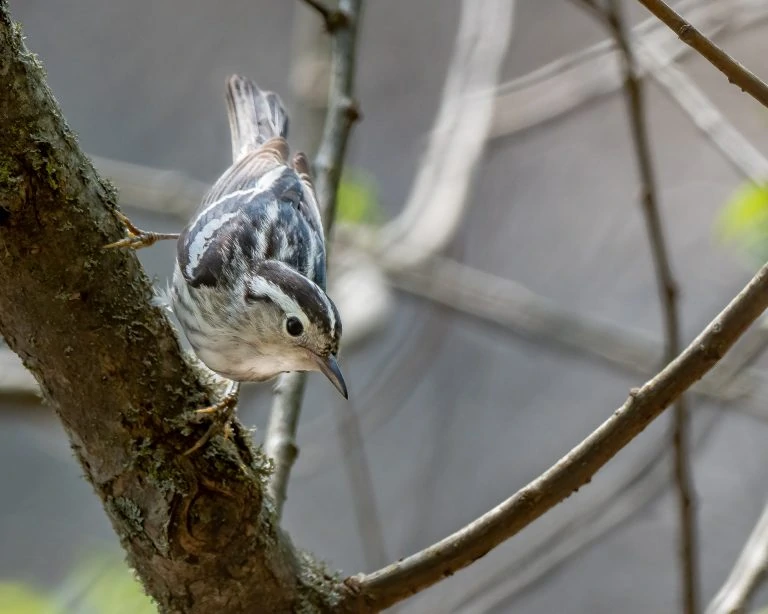
Black-and-white Warblers are quite distinctive and so more easy to identify with their stiped appearance. They can look gray in some light.
Males have a larger black patch across the eye and cheek and are a darker black than females.
- Length: 4.3-5.1 in (11-13 cm)
- Weight: 0.3-0.5 oz (8-15 g)
- Wingspan: 7.1-8.7 in (18-22 cm)
Black-and-white Warblers spend the winter in Florida, along the Gulf Coast and Down through Mexico, Baja California, the Caribbean and into South America.
In spring they head north across the southwestern United States and along the border with Canada from east to west.
They are easy to spot hopping up and down on tree trunks and branches looking for insects.
20. Eastern Wood-Pewee
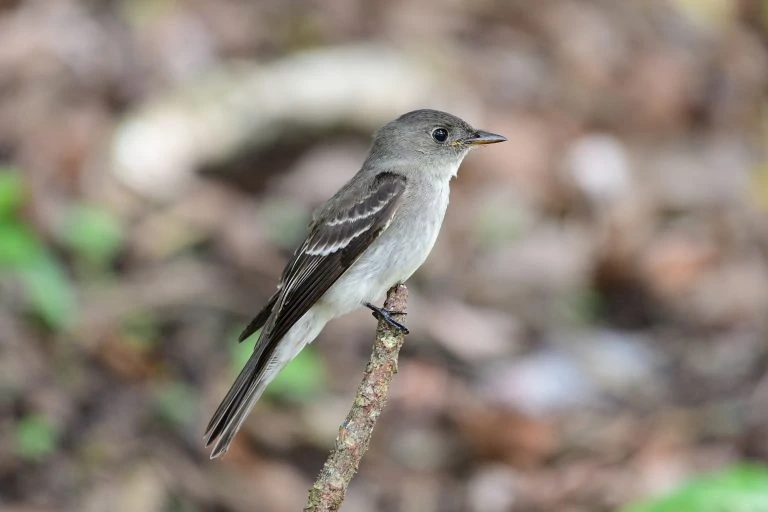
Named after the call they make, the Eastern Wood-Pewee is an unassuming gray flycatcher with off-white undersides.
- Length: 5.9 in (15 cm)
- Weight: 0.3-0.7 oz (10-19 g)
- Wingspan: 9.1-10.2 in (23-26 cm)
Arriving later than most birds from overwintering in South America, the Eastern Wood-Pewee breeds over eastern states and into Canada.
They can often be found perched on exposed branches in forests watching for their prey of small flying insects.
21. Say's Phoebe
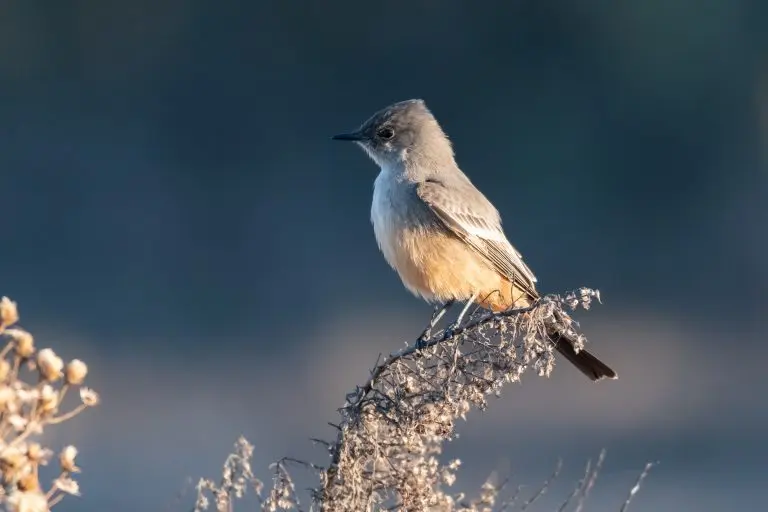
Say's Phoebes are slender, long-tailed flycatchers that are brownish-gray above and with a cinnamon belly, gray breast, and blackish tail.
- Length: 6.7 in (17 cm)
- Weight: 0.7-0.8 oz (21-22 g)
Say's Phoebes breed in Alaska, northwestern Canada, and the northern U.S before migrating south to southwestern states and Mexico. Those in southern states remain all year.
Dry open country including badlands, canyons, and desert borders are the usual habitat of Say's Phoebes.
Say's Phoebe's are flycatchers and their diet is mostly insects such as beetles, crickets, bees, and flies. They often nest on buildings and can be seen perched on fence posts and around buildings or in the nest under an eave.
To attract more Say's Phoebes to your yard put up a nest box or a shelf attached to a building to encourage nesting and plant native trees and shrubs.
Check out these articles if you want to know more about birds in North America:
- Backyard Birds in Every State – Free Picture ID Printable
- Hummingbirds in North America
- Birds with Red Heads
- Small Brown Birds
How to Identify Birds
Here are some tips to help you identify birds so wherever you are birding in Florida you have the knowledge to document and find the bird in a guide:
- Size – Size is the easiest thing to notice about a bird. Birds are often measured in inches or centimeters in guide books. It's best to take a note of the bird in terms of small, medium, or large to be able to look for it later. A small bird is about the size of a sparrow, a medium bird is about the size of a pigeon and a large bird is the size of a goose.
- Shape – Take note of the silhouette of the bird and jot it down or draw the outline. Look at tail length, bill shape, wing shape, and overall body shape.
- Color pattern – Take a note of the main color of the head, back, belly, and wings, and tail for the main color and then any secondary colors or patterns. Also take note of any patterns such as banding, spots, or highlights.
- Behavior – Are they on the ground or high up in the trees. Are they in flocks or on their own? Can you spot what they are eating?
- Habitat – Woodlands, parks, shrubs, grasslands or meadows, shore or marsh.
- Use a bird identificationapp such as those created by ebird or Audubon
Source: https://www.birdadvisors.com/gray-birds/
0 Response to "Gray Bill Blue Hat Birds on Bat Cardinal Hat"
Post a Comment